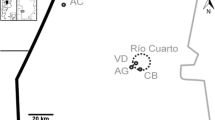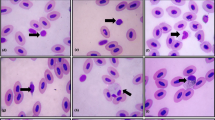Abstract
Four populations of Rhinella arenarum from aquatic environments with different degrees of disturbance in central Argentina were compared to assess the ability of cytomorphology and cytomorphometry of blood cells as a hematological biomarker. A total of 93 specimens of R. arenarum (adults sexually mature) were captured during the spring. From the analysis of cell, no variations were found in terms of morphology, whereas in nuclear and cell areas and Price-Jones curves, we observed a smaller size in erythrocytes of individuals inhabiting the site most altered, “Villa Dalcar,” as well as for leukocytes, lymphocytes, neutrophils, and eosinophils for the same site. This could be caused by presence of different pollutants in the lake. Furthermore, this was confirmed by the high levels of environmental variables (conductivity, total dissolved solids, and salinity) show that Villa Dalcar is the site most affected by human activities.



Similar content being viewed by others
References
Addy K, Green L & Herron, E (2004) pH y Alcalinidad. Kingston: Universidad de Rhode Island. 1-4
Arıkan H (2010) A study on the blood cells of the fire-bellied toad, Bombina bombina L. (Anura: Bombinatoridae). Anim Biol 60:61–68
Arıkan H, Çevik İE, Kaya U, Mermer A (2001) Erythrocytes measurements on Anatolian mountain frogs. Anadolu Univ J Sci Technol—A (AUJST-A) 2:387–391 (in Turkish)
Arserim SK, Mermer A (2008) Hematology of the Uludağ frog, Rana macrocnemis Boulenger, 1885 in Uludağ National Park (Bursa, Turkey). J Fish Aquat Sci 25:39–46
Atatür MK, Arikan H, Mermer A (1998) Erythrocyte sizes of some Urodeles from Turkey. Turk J Zool 22:89–91
Attademo A, Peltzer P, Lajmanovich R (2005) Amphibians occurring in soybean and implications for biological control in Argentina. Agric Ecosyst Environ 106(4):389–394
Baraquet M, Grenat PR, Salas NE, Martino AL (2013) Intraspecific variation in erythrocyte sizes among populations of Hypsiboas cordobae (Anura: Hylidae). Acta Herpetol 8:93–97
Barni S, Boncompagni E, Grosso A, Bertone V, Freitas I, Fasola M, Fenoglio C (2007) Evaluation of Rana esculenta blood cell response to chemicals stressors in the environment during the larval and adult phases. Aquat Toxicol 81:45–54
Bessman JD, Gilmer PR, Gardner FH (1979) Quantitative anisocytosis as a discriminant between iron deficiency and thalassemia Minor. Blood 53(2):288–293
Bionda CL, di Tada IE, Lajmanovich RC (2011) Composition of amphibian assemblages in agroecosystems from the central region of Argentina. Russ J Herpetol 18(2):93–98
Bionda C, Lajmanovich R, Salas N, Martino A, di Tada I (2013) Population demographics of Rhinella arenarum (Anura: Bufonidae) y Physalaemus biligonigerus (Anura: Leiuperidae) in agroecosystems of the Province of Córdoba, Argentina. Rev Biol Trop 61(3):1389–1400 (In Spanish)
Blaunstein AR, Han B, Relyea R, Johnson P, Buck J, Gervasi S, Kats L (2011) The complexity of amphibian population declines: understanding the role of cofactors in driving amphibian losses. Ann N Y Acad Sci 1223:108–119
Blaustein AR, Bancroft BA (2007) Amphibian population declines: evolutionary considerations. Bioscience 57:437–444
Cabagna MC, Lajmanovich RC, Stringhini G, Sanchez-Hernandez JC, Peltzer PM (2005) Hematological parameters of health status in the common toad Bufo arenarum in agroecosystems of Santa Fe Province, Argentina. Appl Herpetol 2:373–380
Cabagna MC, Lajmanovich RC, Attedemo AM, Peltzer PM, Junges CM, Biancucci GF, Bassó A (2011) Hematology and cytochemistry of blood cells of Rhinella fernandezae (Anura: Bufonidae) in Espinal y Delta-Islas of Paraná River, Argentine. Rev Biol Trop 59(1):17–28 (In Spanish)
Cajaraville MP, Bebianno MJ, Blasco J, Porte C, Sarasquete A, Viarengo C (2000) The use of biomarkers to assess the impact of pollution in coastal environments of the Iberian Peninsula: a practical approach. In: Cajaraville MP (ed) Science of the Total Environment. Special issue on towards an integrative approach in environmental contamination and toxicology. Elsevier Science, Oxford, p 247, 295–311
Campbell TW (2004) Hematology of lower vertebrates. Department of Clinical Sciences, College of Veterinary Medicine & Biomedical Sciences, Colorado State University, Fort Collins
Carvalho CS, Utsunomiya HSM, Pasquoto T, Lima R, Costa MJ, Fernandes MN (2016) Blood cell responses and metallothionein in the liver, kidney and muscles of bullfrog tadpoles, Lithobates catesbeianus, following exposure to different metals. Environ Pollut 1–8 doi:https://doi.org/10.1016/ j.envpol.2016.12.012
Chiesa ME, Rosenberg CE, Fink NE, Salibián A (2006) Serum protein profile and blood cell counts in adult toads Bufo arenarum (Amphibia: Anura: Bufonidae): effects of sublethal lead acetate. Arch Environ Contam Toxicol 50:384–391
Coppo JA (2003) The internal medium of “bullfrog” (Rana catesbeiana, Shaw 1802). Literature Review. Rev Vet 14:1
Dacie SJ, Lewis SM (1984) Practical haematology, eight. Churchill, Edinburgh
Davis AK, Cook KC, Altizer S (2004) Leukocyte profiles in wild house finches with and without mycoplasmal conjunctivitis, a recently emerged bacterial disease. EcoHealth 1:362–373
Di Rienzo JA, Casanoves F, Balzarini MG, Gonzalez L, Tablada M, Robledo CW (2012) InfoStat versión 2012. Grupo InfoStat, FCA. Universidad Nacional de Córdoba, Ciudad de Córdoba. URL http://www.infostat.com.ar
Doffo N (1989) Geomorfología del área urbana de la cuarta ciudad de Río y la cuenca del arroyo El baño, algunas consideraciones aplicadas a la gestión del medio ambiente natural. Trabajo final. Universidad Nacional de Río Cuarto, Río Cuarto (In Spanish)
Goniakowska L (1973) Metabolism, resistance to hypotonic solutions, and ultrastructure of erythrocytes of five amphibian species. Acta Biol Crac Ser Zool 13:225–236
Hadji-Azimi I, Coosemans V, Canicatti C (1987) Atlas of adult Xenopus laevis Laevis hematology. Dev Comp Immunol 11:807–874
Javed M, Usmani N (2012) Toxic effects of heavy metals (Cu, Ni, Fe, Co, Mn, Cr, Zn) to the haematology of Mastacembelus armatus thriving in Harduaganj reservoir, Aligarh, India. Glob J Med Res 12(8):1–8
Lajmanovich R, Peltzer P (2008) Plan de monitoreo ambiental para estudiar el impacto del cultivo extensivo de arroz en el macrosistema Iberá. Cátedra de Ecotoxicología. Facultad de Bioquímica y Ciencias Biológicas. Universidad Nacional del Litoral-CONICET (In Spanish)
Mancini M, Rodriguez C, Finola M, Basualdo C, Prosperi C (2000) Mortandad de peces en un lago recreacional del Sur de Córdoba, Argentina. Rev Aquatic 11:1–7 (In Spanish)
Mancini M, Crichigno S, Ortiz M, Haro JG (2012) Lagos urbanos: importancia, dinamismo y multiplicidad de usos. El caso del lago Villa Dálcar (Córdoba, Argentina). Biología acuática 27:175–189 (In Spanish)
Mclaughlin A, Mineau P (1995) The impact of agricultural practices on biodiversity. Agric Ecosyst Environ 55:201–212
Medina MF, Gonzalez ME, Klyver SMR, Aybar Odstrcil IM (2016) Histopathological and biochemical changes in the liver, kidney, and blood of amphibians intoxicated with cadmium. Turk J Biol 40:229–238
Nöller HG (1959) Eine einfache technik der blutentnahme beim frosch. Pflügers Arch Physiol 269:98–100 (In Germany)
Novoa M, Luque E, Lombardo D, de Fabricius A (2006) Estudio ficológico de lagos urbanos artificiales del sur de la provincia de córdoba. Bol Soc Argent Bot 41(3–4):203–231 (In Spanish)
Peltzer PM, Lajmanovich RC, Sánchez-Hernández JC, Cabagna M, Attademo AM, Bassó A (2008) Effects of agricultural pond eutrophication on survival and health status of Scinax Nasicus tadpoles. Ecotoxicol Environ Saf 70:185–197
Pollo FE, Salas NE, Mancini MA, Martino AL (2012) Comparative study of the frequency of micronuclei and nuclear abnormalities in erythrocytes three fish species. Acta Toxicol Argent 20(2):62–67
Pollo FE, Bionda CL, Salinas ZA, Salas NE, Martino AL (2015) Common toad Rhinella arenarum (Hensel, 1867) and its importance in assessing environmental health: test of micronuclei and nuclear abnormalities in erythrocytes. Environ Monit Assess 187:581
Prieto Méndez J, González Ramírez CA, Gutiérrez ADR, Prieto García F (2009) Plant contamination and phytotoxicity due to heavy metals from soil and water. Trop Subtrop Agroecosyst 10:29–44
Priyadarshani S, Madhushani WAN, Jayawardena UA, Wickramasinghe DD, Udagama PV (2015) Heavy metal mediated immunomodulation of the Indian green frog Euphlyctis hexadactylus (Anura: Ranidae) in urban wetlands. Ecotoxicol Environ Saf 116:40–49
Salinas ZA (2012) Biomonitoreo en diferentes ambientes de la provincia de Córdoba mediante el empleo de biomarcadores hematológicos en Bufo arenarum. Trabajo final. Universidad Nacional de Río Cuarto, Río Cuarto (In Spanish)
Salinas ZA, Salas NE, Baraquet M, Martino AL (2015) Biomarcadores hematológicos del sapo común Bufo (Rhinella) arenarum en ecosistemas alterados de la provincia de Córdoba. Acta Toxicol Argent 23(1):25–35 (In Spanish)
Tok CV, Tosunoğlu M, Ayaz D, Çiçek K, Gül Ç (2009) Hematology of the Lycian salamander, Lyciasalamandra fazilae. NW J Zool 5(2):321–329
Varela ME, Sellares ME (1973a) About hematological morphology of Bufo arenarum (Hensel). Rev Soc Argent Biol 13:351–361 (In Spanish)
Varela ME, Sellares ME (1973b) Seasonal variations in the blood picture of Bufo arenarum (Hensel). Rev Soc Argent Biol 13:412–416 (In Spanish)
Wintrobe MM (1933) Variations in the size and hemoglobin content of erythrocytes in the blood of various vertebrates. Folia Haematol 51:32–49
Wojtaszek J, Adamowicz A (2003) Haematology of the fire-bellied toad, Bombina bombina L. Comp Clin Pathol 12:129–134
Young B, Stuart S, Chanson J, Cox N, Boucher T (2004) Jewels are disappearing: the status of amphibians in the new world. Nature Serve, Arlington
Zhelev ZM (2007) Investigation on the blood differential formula in Rana ridibunda (Anura, Amphibia) from the area of the Maritsa-Iztok 1 steam power plant. Acta Zool Bulg 59(2):181–190
Zhelev ZM, Angelov MV, Mollov IA (2006) A study of some metric parameters of the erythrocytes in Rana ridibunda (Amphibia: Anura) derived from an area of highly developed chemical industry. Acta Zool Bulg 58(2):235–244
Zhelev ZM, Mehterov NH, Popgeorgiev GS (2016) Seasonal changes of basic erythrocyte-metric parameters in Pelophylax ridibundus (Amphibia: Ranidae) from anthropogenically polluted biotopes in southern Bulgaria and their role as bioindicators. Ecotoxicol Environ Saf 124:406–417
Zhelev Z, Popgeorgiev G, Ivanov I, Boyadzhiev P (2017) Changes of erythrocyte-metric parameters in Pelophylax ridibundus (Amphibia: Anura: Ranidae) inhabiting water bodies with different types of anthropogenic pollution in southern Bulgaria. Environ Sci Pollut Res. https://doi.org/10.1007/s11356-017-9364-z
Acknowledgements
Financial support was provided by SECyT-UNRC (Grant PPI 18/C416) and FONCyT (Grant PICT 2012-0932). We thank Consejo Nacional de Investigaciones Científicas y Tecnológicas (CONICET)-Argentina for the fellowship that they granted us and Rosie Morgan for the English editing service. The investigation was conducted according to the state law “Protection and Conservation of Wild Fauna” (Argentina National Law No. 22.421). Our study was authorized by Agencia Córdoba Ambiente (A.C.A.S.E.) and Secretaría de Ambiente del Gobierno de Córdoba.
Author information
Authors and Affiliations
Corresponding author
Additional information
Responsible editor: Philippe Garrigues
Rights and permissions
About this article
Cite this article
Salinas, Z.A., Baraquet, M., Grenat, P.R. et al. Morphology and size of blood cells of Rhinella arenarum (Hensel, 1867) as environmental health assessment in disturbed aquatic ecosystem from central Argentina. Environ Sci Pollut Res 24, 24907–24915 (2017). https://doi.org/10.1007/s11356-017-0107-y
Received:
Accepted:
Published:
Issue Date:
DOI: https://doi.org/10.1007/s11356-017-0107-y




